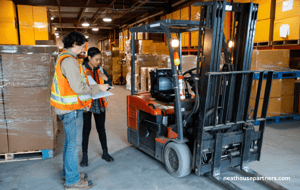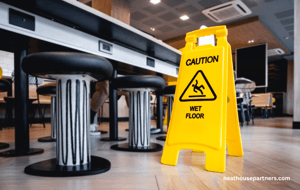Driving Safety Innovation: The Future of Enhanced Safety for Employers
Driving Safety Innovation: The Future of Enhanced Safety for Employers
James Rowland
Commercial Director James leads Account Management, Sales and Marketing at Neathouse Partners.Date
27 July 2023Updated
20 March 2024
Table of contents
Tags
Like many sectors, emerging technology has dramatically reshaped our perception of safety, and driving safety innovation is no different, but how can you incorporate these improvements into your business model, employee training and H&S management plans?

Why Driving Safety Matters
The majority of businesses involve driving as part of the working day.
Whether it’s the commute into the office, sending your employees out on the road to meet the transport and logistics needs of operations or managing warehouses with forklift trucks, driving is a dynamic process, that throws up plenty of Health & Safety concerns for those responsible for managing employee wellbeing and safe working practices.
As an employer, it's not just about the safety of your drivers but also about your responsibility towards them and the wider public, so let’s review some of the advancements in driving safety innovation and how they can apply to your business.
Changes To Be Aware Of
This development of vehicle safety covers key areas like electric or hybrid engines, digital communications, advanced driver assistance systems (ADAS), and more.
- Electric and Hybrid Engines: These aren't just eco-friendly options. Their integration indicates a shift towards a safer, more controlled driving experience.
- Digital Communications: Modern vehicles are becoming increasingly interconnected, offering real-time feedback, communication, and enhanced navigation.
- Advanced Driver Assistance Systems (ADAS): These systems, ranging from parking assists to collision alerts, actively support drivers in navigating complex road scenarios.
Electric and Hybrid Engines: Beyond Eco-Friendliness
These engines are celebrated for their reduced emissions, but did you know that their additional weight due to electrical components makes them less likely to roll over in an accident?
For your business, this means not just an environmental badge of honour but also a tangible increase in safety.
Digital Communications and Monitoring: Always Alert
Modern vehicles often come equipped with monitoring systems, allowing for a level of autonomous driving.
One of the most advanced and widely recognised digital communication and monitoring systems in modern vehicles is Tesla's Autopilot system.
This semi-autonomous driving feature uses cameras, ultrasonic sensors, and radar to perceive its surroundings.
A real-world incident occurred in 2016 when a Tesla Model S, with its Autopilot system engaged, detected an 18-wheel truck on the highway that had lost its load, spilling its contents onto the road. Before the driver could react, the Autopilot system applied the brakes, preventing a possible high-speed collision.
Such instances provide a practical example of how digital communications and monitoring systems in modern vehicles can play a pivotal role in enhancing road safety.
They serve as a testament to the emphasis placed by organisations like the DVLA and HSE on integrating such technologies to ensure drivers' safety and reduce potential liabilities for businesses.
Surround View Cameras: More Eyes on the Road
These cameras give drivers a comprehensive view of their surroundings, proving invaluable during parking or overtaking.
As an employer, offering vehicles with such systems can reduce minor accidents, thereby ensuring your fleet's longevity, preventing insurance claims, and reducing downtimes.
Hands-free Driving: The Double-Edged Sword
Hands-free driving systems, at their core, are designed to facilitate multitasking.
Drivers can manage calls, adjust in-car entertainment, or even retrieve directions without the need to divert their hands from the steering wheel.
A Word of Caution from the Experts
The National Safety Council has sounded a note of caution and a reminder that the true essence of safe driving isn't just about hands on the wheel but also ensuring eyes on the road and minds remain vigilant.
For businesses and employers, this means going beyond providing vehicles with advanced features.
It's equally, if not more, essential to ensure drivers are educated about the potential distractions hands-free functionalities might introduce.
By doing so, businesses can strike a balance between leveraging driving safety innovation and ensuring their employees remain attentive and safe on the road.
Anti-lock Brakes
Since their introduction in 1966, anti-lock brakes have been instrumental in preventing skidding and ensuring better vehicle control.
Incorporating vehicles with improved braking systems is not just about adhering to safety standards but also about the proactive protection of your employees.
For employers, staying abreast of these changes isn't just a matter of compliance.
It signifies a commitment to employee safety, aligning with both ethical standards and UK H&S regulations.
Why Employers Need to Prioritise Driving Safety Innovation
Driving Safety Innovation isn't just about embracing the future; it also holds significant consequences for businesses in terms of their obligations under Health & Safety Management too as shown by the examples below.
- Legal Responsibility: The Health and Safety at Work etc. Act 1974 and the Management of Health and Safety at Work Regulations 1999 require employers to ensure, as far as is reasonably practicable, the health and safety of all employees while at work. This extends to driving tasks.
- Financial Implications: Accidents can lead to vehicle repair costs, increased insurance premiums, and potential legal fees.
- Reputation Management: A commitment to safety can enhance your company's reputation, while accidents can tarnish it.
Legal Responsibility
The Health and Safety at Work etc. Act 1974 and the Management of Health and Safety at Work Regulations 1999 are not mere guidelines, they mandate the need to prioritise the health and safety of your workforce.
A UK-based logistics company faced legal repercussions after failing to provide adequate driving safety training to their employees.
A minor road mishap led to an investigation, which unveiled that the company hadn't ensured its drivers were familiar with new safety technologies in the fleet vehicles.
This negligence resulted in substantial penalties and was a stark reminder that the duty of care extends to driving tasks.
Financial Implications
Accidents are costly. Beyond the immediate repair bills, the ripple effects can be significant.
After a series of minor road incidents, a UK delivery service saw its insurance premiums skyrocket.
What was initially viewed as 'small, manageable incidents' led to an annual insurance cost increase of over 25%.
Add to that the potential legal fees and downtime for vehicle repairs, and the financial burden became sizeable.
Reputation Management
In an era where corporate responsibility is under the microscope, a commitment to safety isn't just right; it's also smart business.
A UK-based cab service launched an initiative emphasising its driver training, particularly around the latest driving safety innovations.
This proactive approach not only reduced accident rates but also positioned the company as a leader in passenger safety.
In contrast, another ride-hailing giant faced significant backlash in the media after a series of accidents, significantly impacting user trust and their market share.
In essence, these real-world applications underscore the multifaceted reasons employers should not only be aware of but proactively engage with driving safety innovations.
Conclusion
With the rapid advancements in vehicle technology, employers face a dual responsibility: to embrace these innovations for the safety of their employees and the wider public and to remain compliant with UK H&S regulations.
The implications stretch beyond mere compliance, impacting financial health, company reputation, and most importantly, the lives of those on the road.
By proactively integrating driving safety innovation into their business models, employers are not only future-proofing their operations but are also demonstrating a commitment to safeguarding their most valuable assets: their employees.
Next Steps
Whether you're an SME, a large company, or an HR department striving for excellence in driving safety, our expert team can help.
With tailored consultations, bespoke training modules, dynamic HR policy development, timely legislation updates, and dependable support during claims and liabilities, we can help you to ensure your team stay safe and well-informed when rolling out driving safety innovation at work.
Related blog posts

Safety in Construction: A Snapshot for Employers

Forklift Truck Workplace Safety

Contractor Health & Safety
Have questions?
Get in touch today
Contact us, and our team will get back to you within 24 hours. We value your questions and are committed to getting them answered quickly.


Hello! I am Nicky
Just fill in the form below with your details, and I will arrange for a member of our team to give you a call.
By clicking, you agree to our Privacy Policy






